Satellite-Based Water and Energy Balance Model for the Arid Region to Determine Evapotranspiration: Development and Application
Abstract
:1. Introduction
Objectives
- Develop a new model to detect spatial and temporal ETa estimates for hyper-arid regions.
- Apply the developed model to estimate the ETa of date palm trees in the hyper-arid region of Oman.
- Validate the developed model and its performance accuracy against in situ measurements of ETa via sap flow sensors and lysimeters.
- Evaluate the developed model against three existing models, including SEBAL, METRIC, and PM.
2. Materials and Methods
2.1. Study Area
2.2. Satellite Imagery
2.3. Satellite-Based Water and Energy Balance Model for the Arid Region to Determine Evapotranspiration (SMARET) Model Development
2.4. SMARET Model Validation and Evaluation
2.4.1. Lysimeters
2.4.2. Surface Energy Balance for Land (SEBAL)
2.4.3. Mapping Evapotranspiration at High Resolution with Internalized Calibration (METRIC)
2.4.4. Modified Penman–Monteith (PM) Model
3. Results and Discussions
3.1. Albedo (α) vs. Normalized Difference Vegetation Indices (NDVI)
3.2. Land Surface Temperature (LST) vs. Normalized Difference Vegetation Indices (NDVI)
3.3. Land Surface Temperature (LST) vs. In Situ Soil Temperature (Ts)
3.4. The Magnitude of Energy Fluxes
3.5. Magnitude of Actual Evapotraspiration (ETa)
4. Validation
5. Conclusions
Author Contributions
Funding
Institutional Review Board Statement
Informed Consent Statement
Data Availability Statement
Conflicts of Interest
References
- Brown, J.J.; Das, P.; Al-Saidi, M. Sustainable Agriculture in the Arabian/Persian Gulf Region Utilizing Marginal Water Resources: Making the Best of a Bad Situation. Sustainability 2018, 10, 1364. [Google Scholar] [CrossRef] [Green Version]
- Dodds, P.E.; Barton, A.; Meyer, W.S. Review of Methods to Estimate Irrigated Reference Crop Evapotranspiration Across Aus-tralia; Technical Report 04/05; CRC for Irrigation Futures and CSIRO Land and Water: Adelaide, SA, Australia, 2005. [Google Scholar]
- Li, Z.L.; Tang, R.; Wan, Z.; Bi, Y.; Zhou, C.; Tang, B.; Yan, G.; Zhang, X. A review of current methodologies for regional evapo-transpiration estimation from remotely sensed data. Sensors 2009, 9, 3801–3853. [Google Scholar] [CrossRef] [Green Version]
- Zhang, K.; Ma, J.; Zhu, G.; Ma, T.; Han, T.; Feng, L.L. Parameter sensitivity analysis and optimization for a satellite-based evap-otranspiration model across multiple sites using Moderate Resolution Imaging Spectroradiometer and flux data. J. Geo-Phys. Res. Atmos. 2017, 122, 230–245. [Google Scholar] [CrossRef]
- Zhang, K.; Kimball, J.S.; Running, S.W. A review of remote sensing based actual evapotranspiration estimation. Wiley Interdiscip. Rev. Water 2016, 3, 834–853. [Google Scholar] [CrossRef]
- Eagleman, J.R. Pan evaporation, potential and actual evapotranspiration. J. Appl. Meteorol. Climatol. 1967, 6, 482–488. [Google Scholar] [CrossRef] [Green Version]
- Sakuratani, T. A Heat Balance Method for Measuring Water Flux in the Stem of Intact Plants. J. Agric. Meteorol. 1981, 37, 9–17. [Google Scholar] [CrossRef]
- Running, S.; Baldocchi, D.; Turner, D.; Gower, S.; Bakwin, P.; Hibbard, K. A Global Terrestrial Monitoring Network Integrating Tower Fluxes, Flask Sampling, Ecosystem Modeling and EOS Satellite Data. Remote Sens. Environ. 1999, 70, 108–127. [Google Scholar] [CrossRef]
- Allen, R.; Irmak, A.; Trezza, R.; Hendrickx, J.M.H.; Bastiaanssen, W.; Kjaersgaard, J. Satellite-based ET estimation in agriculture using SEBAL and METRIC. Hydrol. Process. 2011, 25, 4011–4027. [Google Scholar] [CrossRef]
- Allen, R.G.; Pereira, L.S.; Raes, D.; Smith, M. Crop Evapotranspiration—Guidelines for Computing Crop Water Requirements; FAO Irrigation and Drainage Paper 56; FAO: Rome, Italy, 1998; Volume 300, p. D05109. [Google Scholar]
- Allen, R.G.; Walter, I.A.; Elliott, R.; Itenfisu, D.; Brown, P.; Jensen, M.E.; Mecham, B.; Howell, T.A.; Snyder, R.; Eching, S.; et al. Task Committee on Standardization of Reference Evapotranspiration. 2005. ASCE: Reston, VA, USA. Available online: https://epic.awi.de/id/eprint/42362/1/ascestzdetmain2005.pdf (accessed on 8 January 2018).
- Seemann, S.W.; Li, J.; Menzel, W.P.; Gumley, L.E. Operational Retrieval of Atmospheric Temperature, Moisture, and Ozone from MODIS Infrared Radiances. J. Appl. Meteorol. 2003, 42, 1072–1091. [Google Scholar] [CrossRef]
- Pereira, L.S.; Teodoro, P.R.; Rodrigues, P.N.; Teixeira, J.L. Irrigation scheduling simulation: The model ISAREG. In Tools for Drought Mitigation in Mediterranean Regions; Springer: Dordrecht, The Netherland, 2003; pp. 161–180. [Google Scholar]
- Liu, Y.; Teixeira, J.; Zhang, H.; Pereira, L. Model validation and crop coefficients for irrigation scheduling in the North China plain. Agric. Water Manag. 1998, 36, 233–246. [Google Scholar] [CrossRef]
- Idso, S.B.; Aase, J.K.; Jackson, R.D. Net radiation—Soil heat flux relations as influenced by soil water content variations. Boundary-Layer Meteorol. 1975, 9, 113–122. [Google Scholar] [CrossRef]
- Jackson, R. Evaluating evapotranspiration at local and regional scales. Proc. IEEE 1985, 73, 1086–1096. [Google Scholar] [CrossRef]
- Norman, J.M.; Kustas, W.P.; Humes, K.S. Source approach for estimating soil and vegetation energy fluxes in observations of directional radiometric surface temperature. Agric. For. Meteorol. 1995, 77, 263–293. [Google Scholar] [CrossRef]
- Anderson, M.C.; Norman, J.M.; Mecikalski, J.R.; Otkin, J.A.; Kustas, W.P. A climatological study of evapotranspiration and moisture stress across the continental United States based on thermal remote sensing: 1. Model formulation. J. Geophys. Res. Space Phys. 2007, 112. [Google Scholar] [CrossRef]
- Sun, Z.; Wang, Q.; Matsushita, B.; Fukushima, T.; Ouyang, Z.; Watanabe, M.; Gebremichael, M. Further evaluation of the Sim-ReSET model for ET estimation driven by only satellite inputs. Hydrol. Sci. J. 2013, 58, 994–1012. [Google Scholar] [CrossRef] [Green Version]
- Irmak, A.; Kamble, B. Evapotranspiration data assimilation with genetic algorithms and SWAP model for on-demand irrigation. Irrig. Sci. 2009, 28, 101–112. [Google Scholar] [CrossRef]
- Losgedaragh, S.Z.; Rahimzadegan, M. Evaluation of SEBS, SEBAL, and METRIC models in estimation of the evaporation from the freshwater lakes (Case study: Amirkabir dam, Iran). J. Hydrol. 2018, 561, 523–531. [Google Scholar] [CrossRef]
- Bastiaanssen, W.; Menenti, M.; Feddes, R.; Holtslag, B. A remote sensing surface energy balance algorithm for land (SEBAL). 1. Formulation. J. Hydrol. 1998, 212-213, 198–212. [Google Scholar] [CrossRef]
- Bastiaanssen, W.G.; Pelgrum, H.; Wang, J.; Ma, Y.; Moreno, J.F.; Roerink, G.J.; Van der Wal, T. A remote sensing surface energy balance algorithm for land (SEBAL).: Part 2: Validation. J. Hydrol. 1998, 212, 213–229. [Google Scholar] [CrossRef]
- Al Zayed, I.S.; Elagib, N.A.; Ribbe, L.; Heinrich, J. Satellite-based evapotranspiration over Gezira Irrigation Scheme, Sudan: A comparative study. Agric. Water Manag. 2016, 177, 66–76. [Google Scholar] [CrossRef]
- Bastiaanssen, W. SEBAL-based sensible and latent heat fluxes in the irrigated Gediz Basin, Turkey. J. Hydrol. 2000, 229, 87–100. [Google Scholar] [CrossRef]
- Sun, H.; Yang, Y.; Wu, R. Improving estimation of cropland evapotranspiration by the Bayesian model averaging method with surface energy balance models. Atmosphere 2019, 10, 188. [Google Scholar] [CrossRef] [Green Version]
- Mkhwanazi, M.; Chávez, J.L.; Andales, A.A. SEBAL-A: A Remote Sensing ET Algorithm that Accounts for Advection with Limited Data. Part I: Development and Validation. Remote Sens. 2015, 7, 15046–15067. [Google Scholar] [CrossRef] [Green Version]
- Allen, R.G.; Burnett, B.; Kramber, W.; Huntington, J.; Kjaersgaard, J.; Kilic, A.; Kelly, C.; Trezza, R. Automated Calibration of the METRIC-Landsat Evapotranspiration Process. JAWRA J. Am. Water Resour. Assoc. 2013, 49, 563–576. [Google Scholar] [CrossRef]
- French, A.N.; Hunsaker, D.J.; Thorp, K.R. Remote sensing of evapotranspiration over cotton using the TSEB and METRIC energy balance models. Remote Sens. Environ. 2015, 158, 281–294. [Google Scholar] [CrossRef]
- Kjaersgaard, J.; Allen, R.; Irmak, A. Improved methods for estimating monthly and growing season ET using METRIC applied to moderate resolution satellite imagery. Hydrol. Process. 2011, 25, 4028–4036. [Google Scholar] [CrossRef]
- Trezza, R. Evapotranspiration from a remote sensing model for water management in an irrigation system in Venezuela. Interciencia 2006, 31, 417–423. [Google Scholar]
- Roerink, G.; Su, Z.; Menenti, M. S-SEBI: A simple remote sensing algorithm to estimate the surface energy balance. Phys. Chem. Earth Part B Hydrol. Ocean. Atmos. 2000, 25, 147–157. [Google Scholar] [CrossRef]
- Bhattarai, N.; Shaw, S.B.; Quackenbush, L.J.; Im, J.; Niraula, R. Evaluating five remote sensing based single-source surface energy balance models for estimating daily evapotranspiration in a humid subtropical climate. Int. J. Appl. Earth Obs. 2016, 49, 75–86. [Google Scholar] [CrossRef]
- Rocha, N.; Käfer, P.; Skokovic, D.; Veeck, G.; Diaz, L.; Kaiser, E.; Carvalho, C.; Cruz, R.; Sobrino, J.; Roberti, D.; et al. The Influence of Land Surface Temperature in Evapotranspiration Estimated by the S-SEBI Model. Atmosphere 2020, 11, 1059. [Google Scholar] [CrossRef]
- Galleguillos, M.; Jacob, F.; Prevot, L.; Lagacherie, P.; Liang, S. Mapping Daily Evapotranspiration Over a Mediterranean Vineyard Watershed. IEEE Geosci. Remote Sens. Lett. 2010, 8, 168–172. [Google Scholar] [CrossRef]
- Kumar, U.; Sahoo, B.; Chatterjee, C.; Raghuwanshi, N.S. Evaluation of Simplified Surface Energy Balance Index (S-SEBI) Method for Estimating Actual Evapotranspiration in Kangsabati Reservoir Command Using Landsat 8 Imagery. J. Indian Soc. Remote Sens. 2020, 48, 1421–1432. [Google Scholar] [CrossRef]
- dos Santos, C.A.C.; Mariano, D.A.; Nascimento, F.D.C.A.D.; Dantas, F.R.D.C.; de Oliveira, G.; Silva, M.T.; da Silva, L.L.; da Silva, B.B.; Bezerra, B.; Safa, B.; et al. Spatio-temporal patterns of energy exchange and evapotranspiration during an intense drought for drylands in Brazil. Int. J. Appl. Earth Obs. Geoinf. 2019, 85, 101982. [Google Scholar] [CrossRef]
- Madugundu, R.; Al-Gaadi, K.A.; Tola, E.; Hassaballa, A.A.; Patil, V.C. Performance of the METRIC model in estimating evapotranspiration fluxes over an irrigated field in Saudi Arabia using Landsat-8 images. Hydrol. Earth Syst. Sci. 2017, 21, 6135–6151. [Google Scholar] [CrossRef] [Green Version]
- Nisa, Z.; Khan, M.; Govind, A.; Marchetti, M.; Lasserre, B.; Magliulo, E.; Manco, A. Evaluation of SEBS, METRIC-EEFlux, and QWaterModel Actual Evapotranspiration for a Mediterranean Cropping System in Southern Italy. Agronomy 2021, 11, 345. [Google Scholar] [CrossRef]
- Ali, A.; Al-Mulla, Y.A.; Charabi, Y.; Al-Wardy, M.; Al-Rawas, G. Use of multispectral and thermal satellite imagery to determine crop water requirements using SEBAL, METRIC, and SWAP models in hot and hyper-arid Oman. Arab. J. Geosci. 2021, 14, 1–21. [Google Scholar] [CrossRef]
- Yu, X.; Guo, X.; Wu, Z. Land Surface Temperature Retrieval from Landsat 8 TIRS—Comparison between Radiative Transfer Equation-Based Method, Split Window Algorithm and Single Channel Method. Remote Sens. 2014, 6, 9829–9852. [Google Scholar] [CrossRef] [Green Version]
- Farah, H.O.; Bastiaanssen, W.G.M. Impact of spatial variations of land surface parameters on regional evaporation: A case study with remote sensing data. Hydrol. Process. 2001, 15, 1585–1607. [Google Scholar] [CrossRef]
- Coll, C.; Caselles, V.; Sobrino, J.A.; Valor, E. On the atmospheric dependence of the split-window equation for land surface temperature. Int. J. Remote Sens. 1994, 15, 105–122. [Google Scholar] [CrossRef]
- Sandholt, I.; Rasmussen, K.; Andersen, J. A simple interpretation of the surface temperature/vegetation index space for assess-ment of surface moisture status. Remote Sens. Environ. 2002, 79, 213–224. [Google Scholar] [CrossRef]
- Marzban, F.; Sodoudi, S.; Preusker, R. The influence of land-cover type on the relationship between NDVI–LST and LST-T air. Int. J. Remote. Sens. 2018, 39, 1377–1398. [Google Scholar] [CrossRef]
- Friedl, M. Forward and inverse modeling of land surface energy balance using surface temperature measurements. Remote Sens. Environ. 2002, 79, 344–354. [Google Scholar] [CrossRef]
- Paulson, C.A. The mathematical representation of wind speed and temperature profiles in the unstable atmospheric surface layer. J. Appl. Meteorol. Climatol. 1970, 9, 857–861. [Google Scholar] [CrossRef]
- Webb, E.K. Profile relationships: The log-linear range, and extension to strong stability. Q. J. R. Meteorol. Soc. 1970, 96, 67–90. [Google Scholar] [CrossRef]
- Lorite, I.; Santos, C.; Testi, L.; Fereres, E. Design and construction of a large weighing lysimeter in an almond orchard. Span. J. Agric. Res. 2012, 10, 238–250. [Google Scholar] [CrossRef] [Green Version]
- Abdulkareem, J.; Abdulkadir, A.; Abdu, N. A Review of Different Types of Lysimeter Used in Solute Transport Studies. Int. J. Plant Soil Sci. 2015, 8, 1–14. [Google Scholar] [CrossRef]
- Ali, A.; Al-Mulla, Y. Comparative Analysis of two Remote Sensing Models Estimating Evapotranspiration of As’Suwaiq Region. In Proceedings of the 2020 Mediterranean and Middle-East Geoscience and Remote Sensing Symposium (M2GARSS), Tunis, Tunisia, 9–11 March 2020. [Google Scholar] [CrossRef]
- Denmead, O. Comparative micrometeorology of a wheat field and a forest of Pinus radiata. Agric. Meteorol. 1969, 6, 357–371. [Google Scholar] [CrossRef]
- Szeicz, G.; Van Bavel, C.; Takami, S. Stomatal factor in the water use and dry matter production by sorghum. Agric. Meteorol. 1973, 12, 361–389. [Google Scholar] [CrossRef]
- Uchijima, Z. Microclimate of the rice crop. In Climate and Rice; IRRI: LosBaños, Philippines, 1976; pp. 115–140. [Google Scholar]
- Baldocchi, D.D.; Verma, S.B.; Rosenberg, N.J. Water use efficiency in a soybean field: Influence of plant water stress. Agric. For. Meteorol. 1985, 34, 53–65. [Google Scholar] [CrossRef]
- Clothier, B.E.; Clawson, K.L.; Pinter Jr, P.J.; Moran, M.S.; Reginato, R.J.; Jackson, R.D. Estimation of soil heat flux from net radia-tion during the growth of alfalfa. Agric. For. Meteorol. 1986, 37, 319–329. [Google Scholar] [CrossRef]

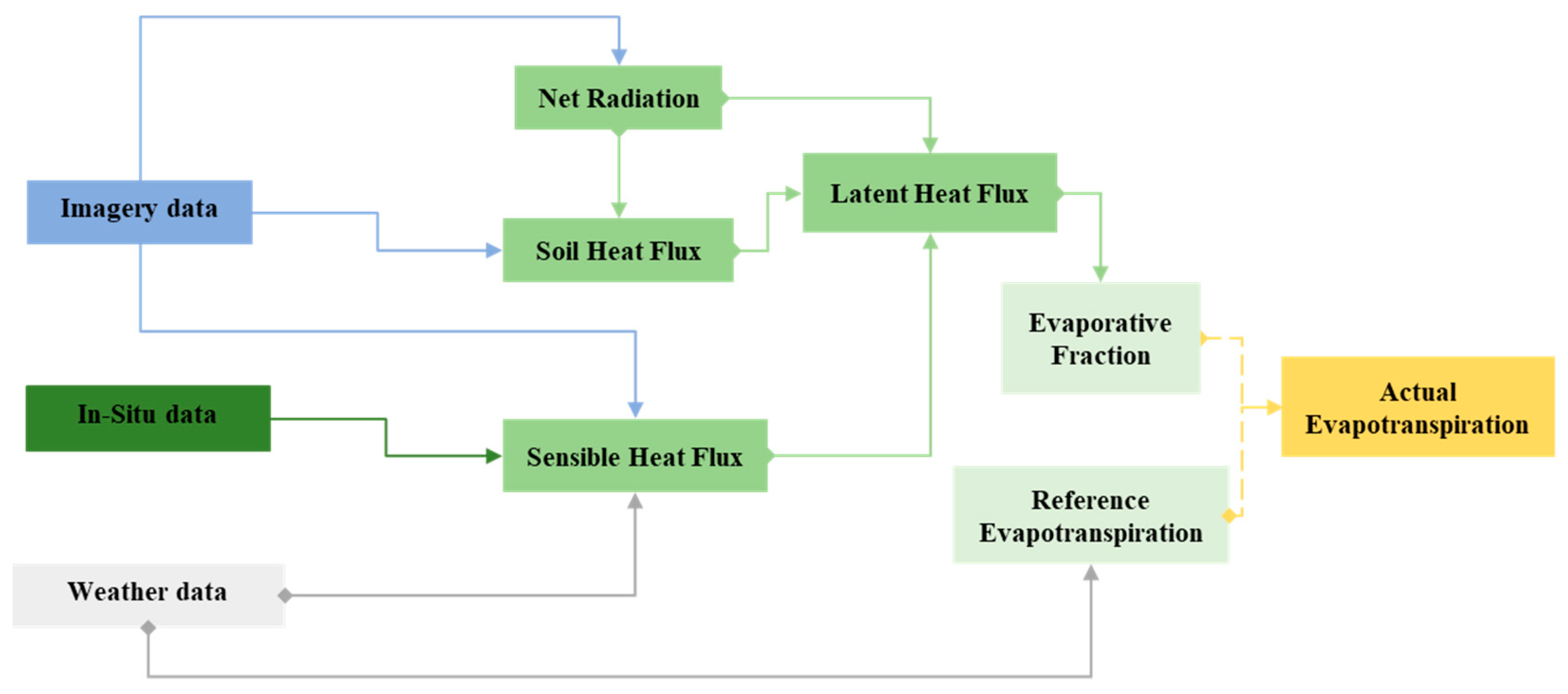

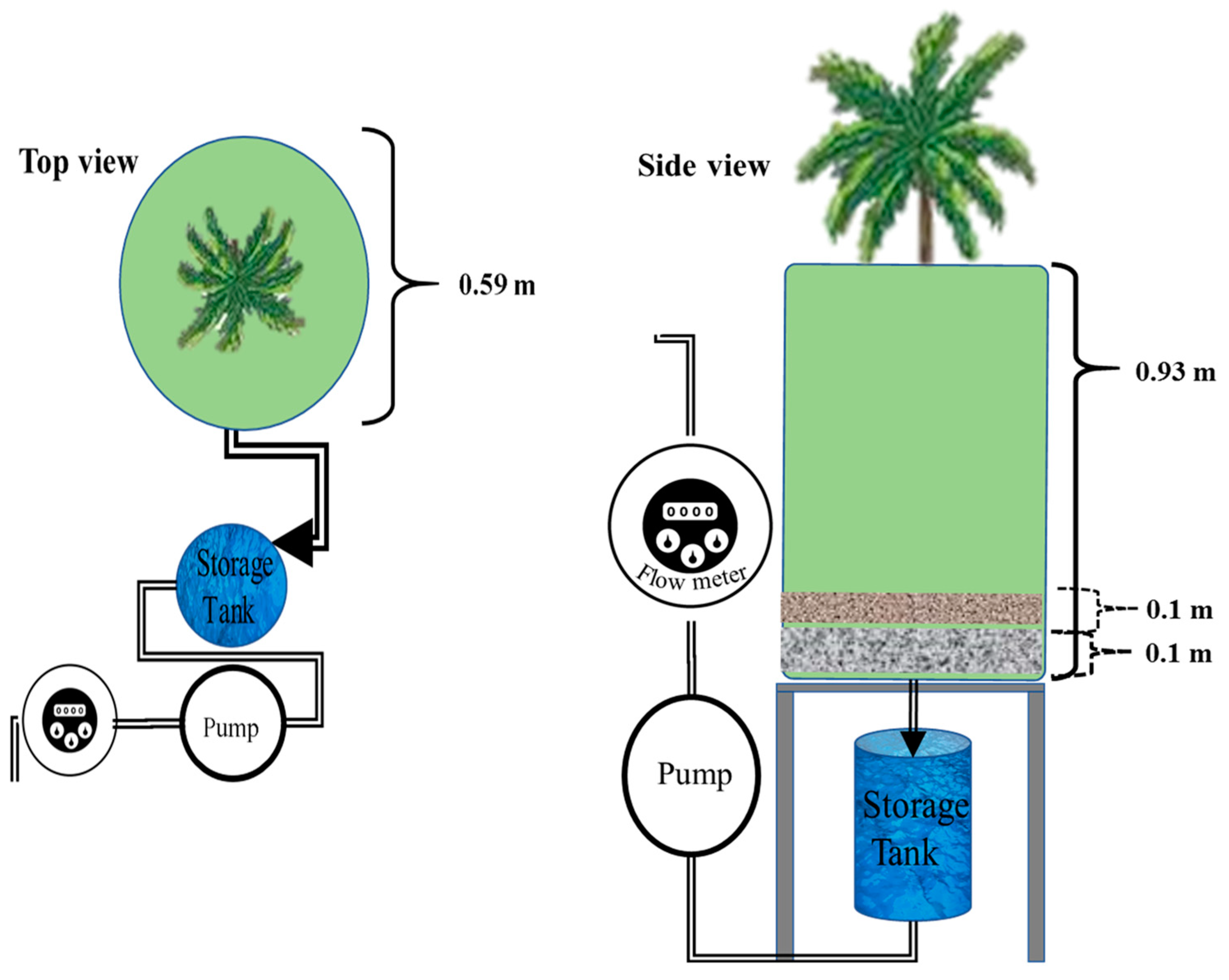
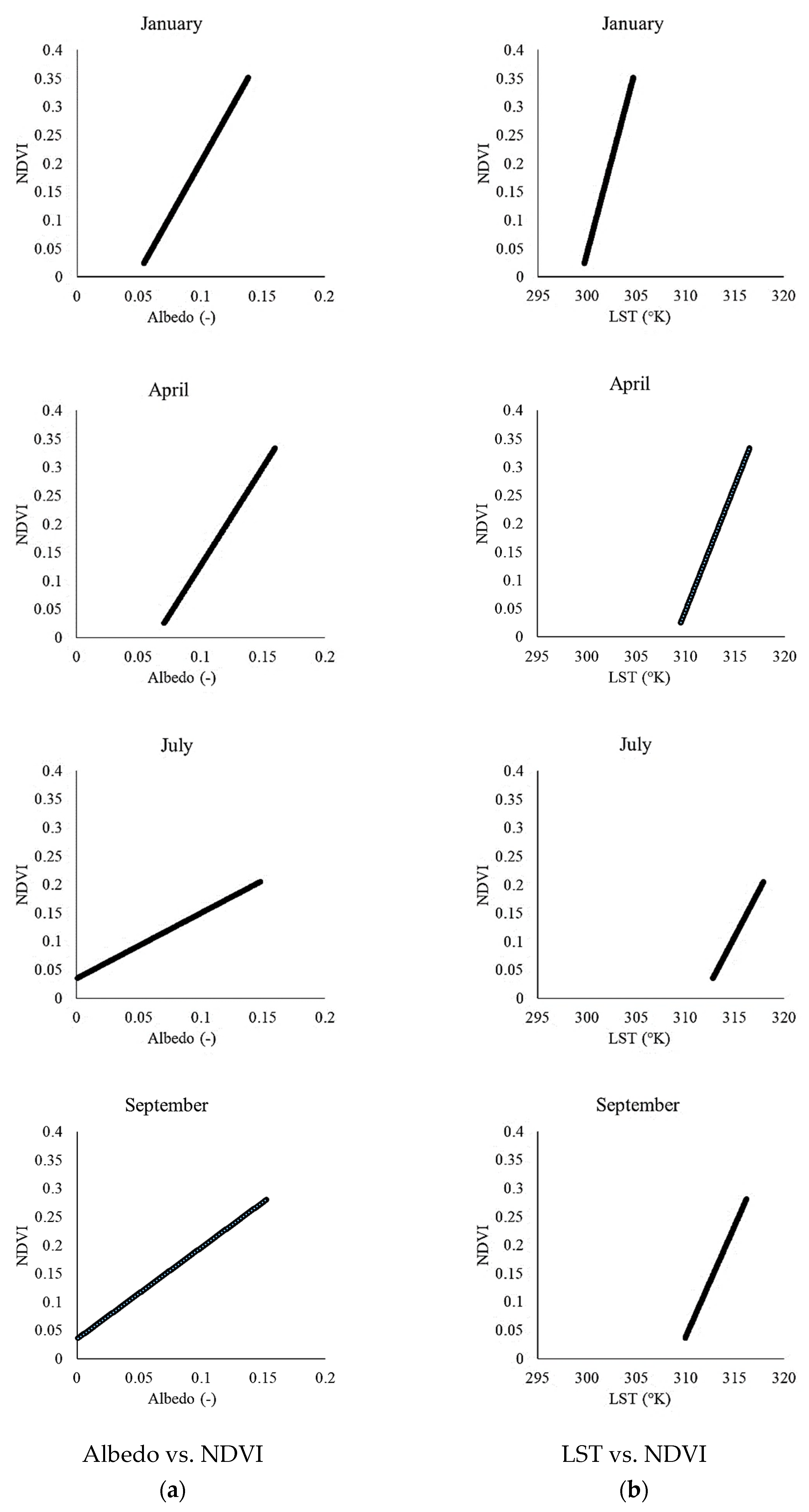
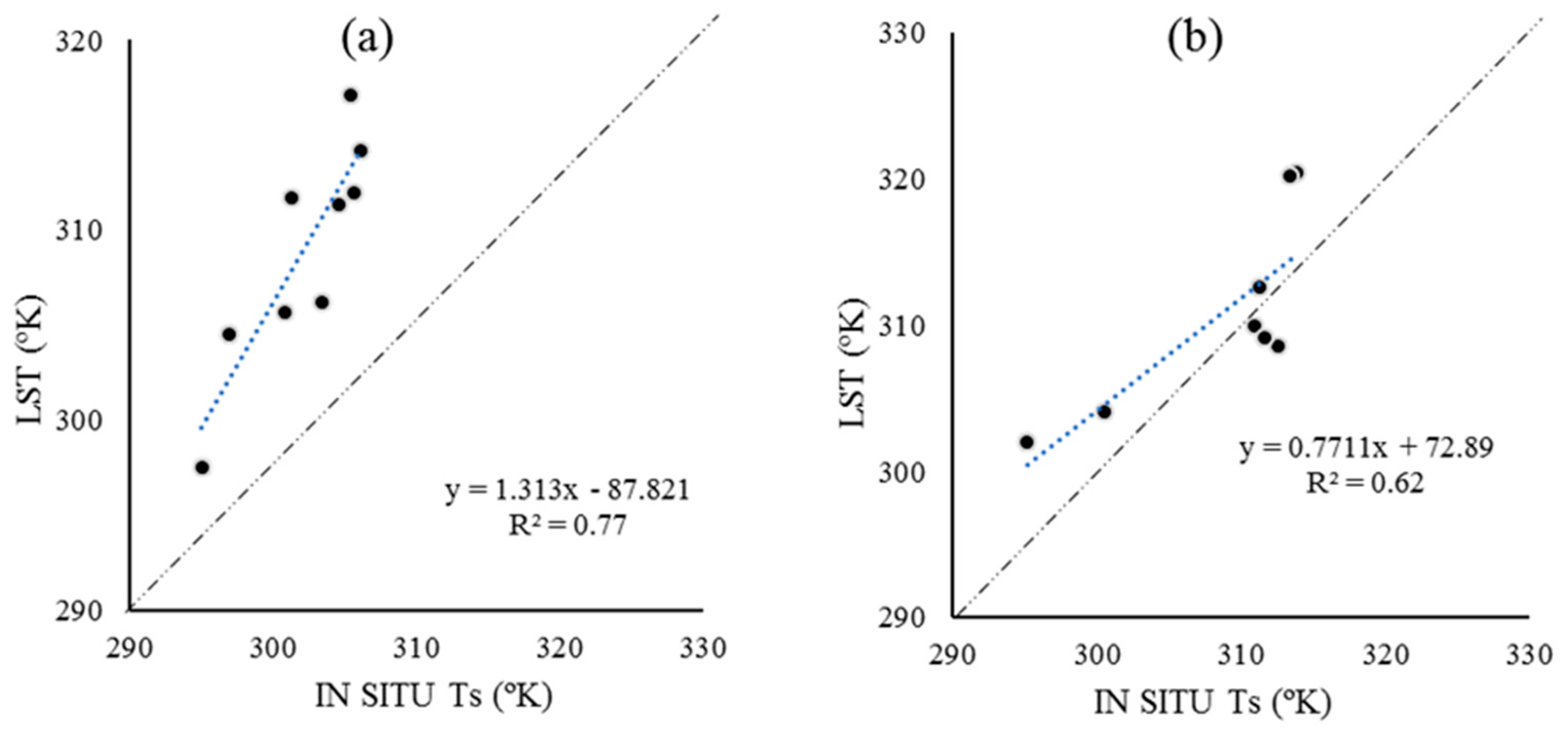

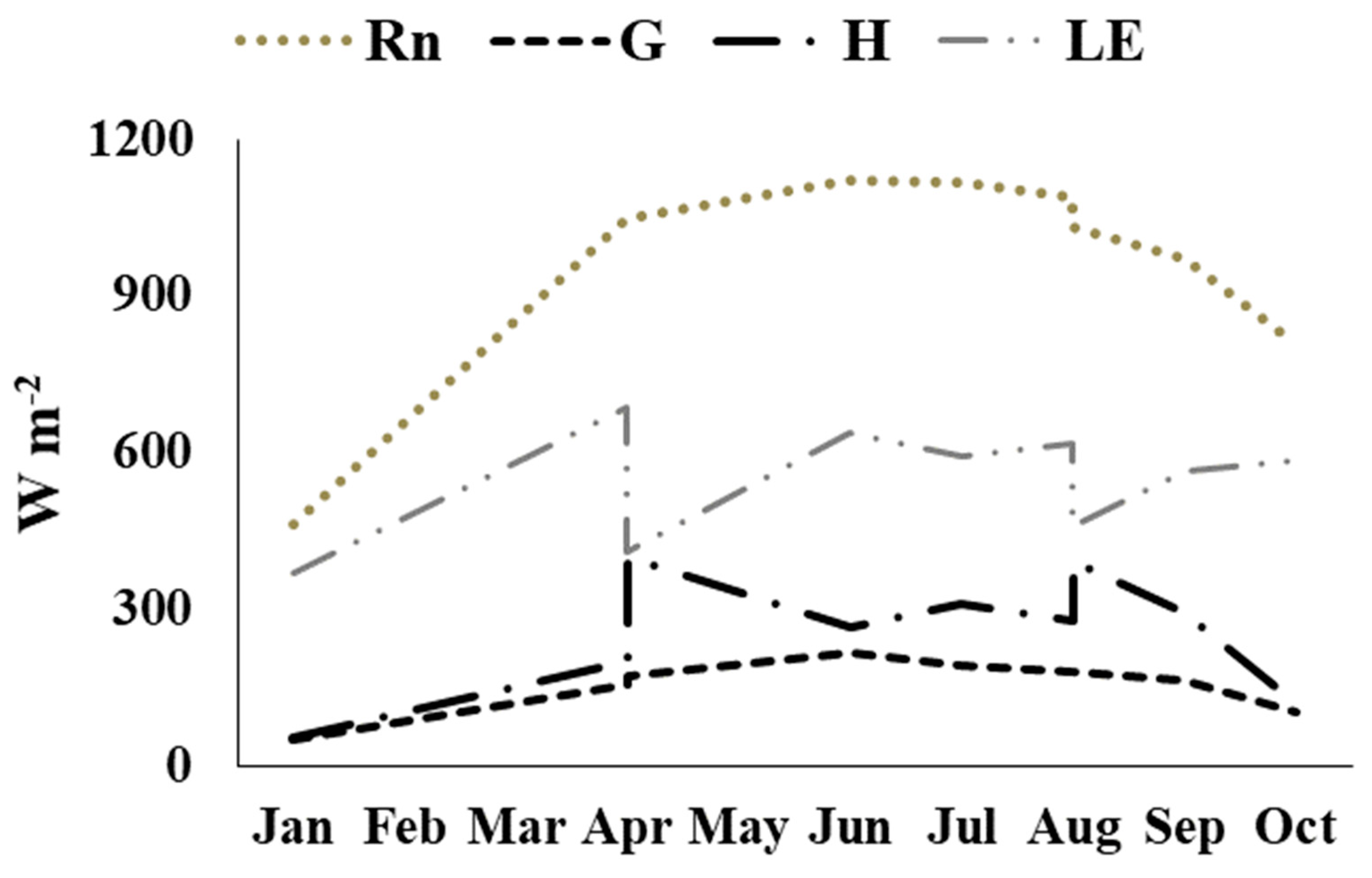
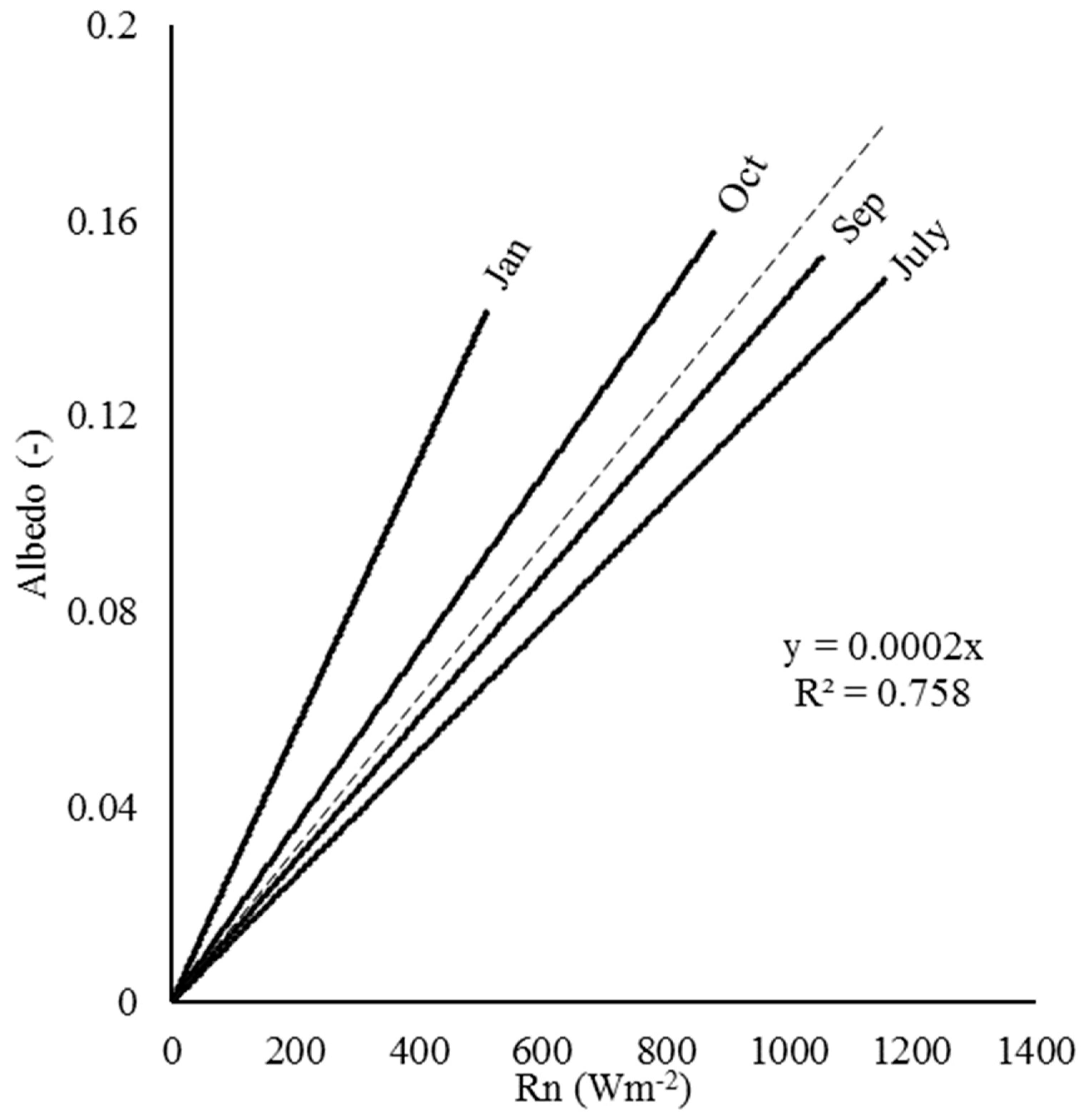
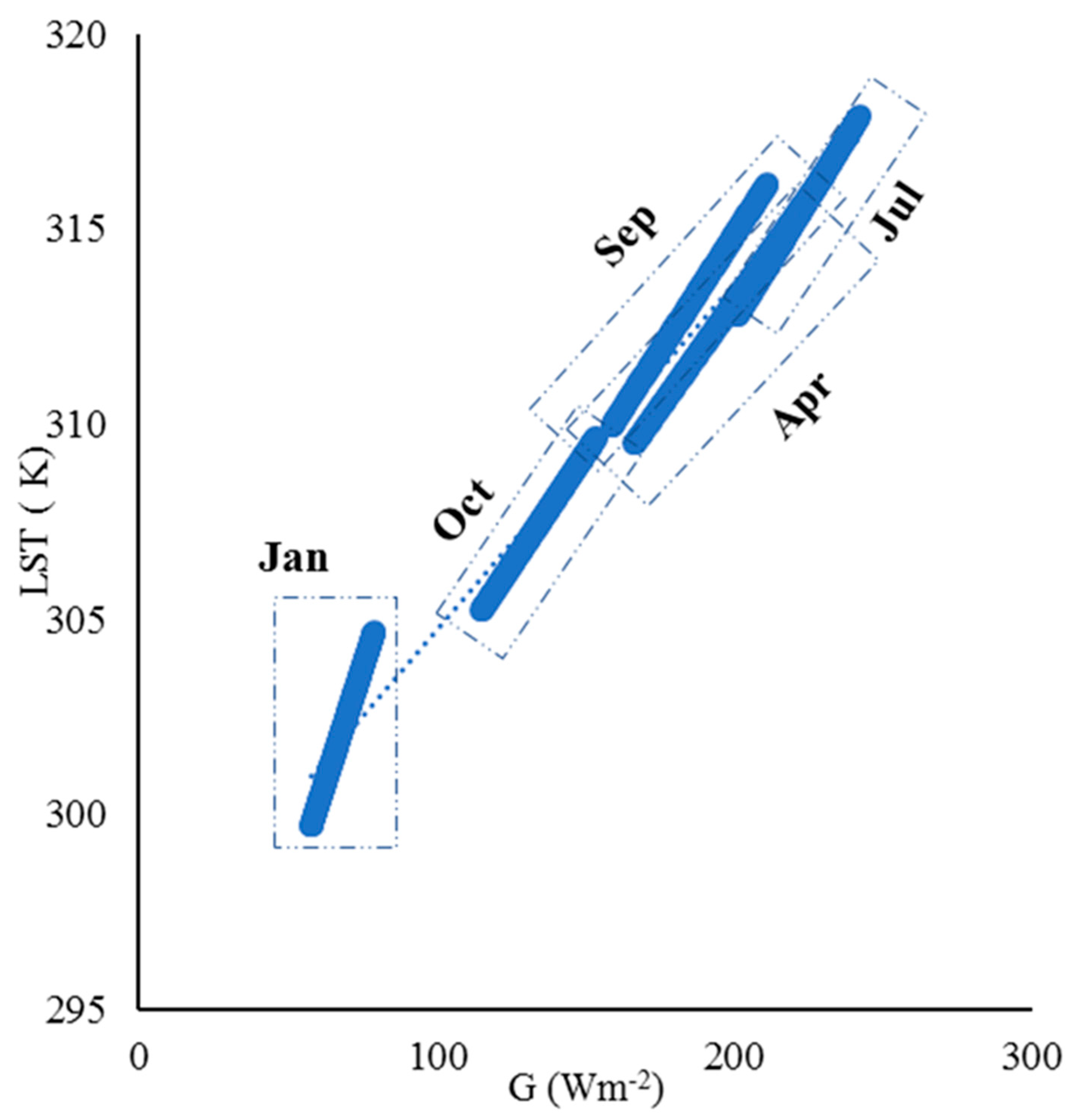



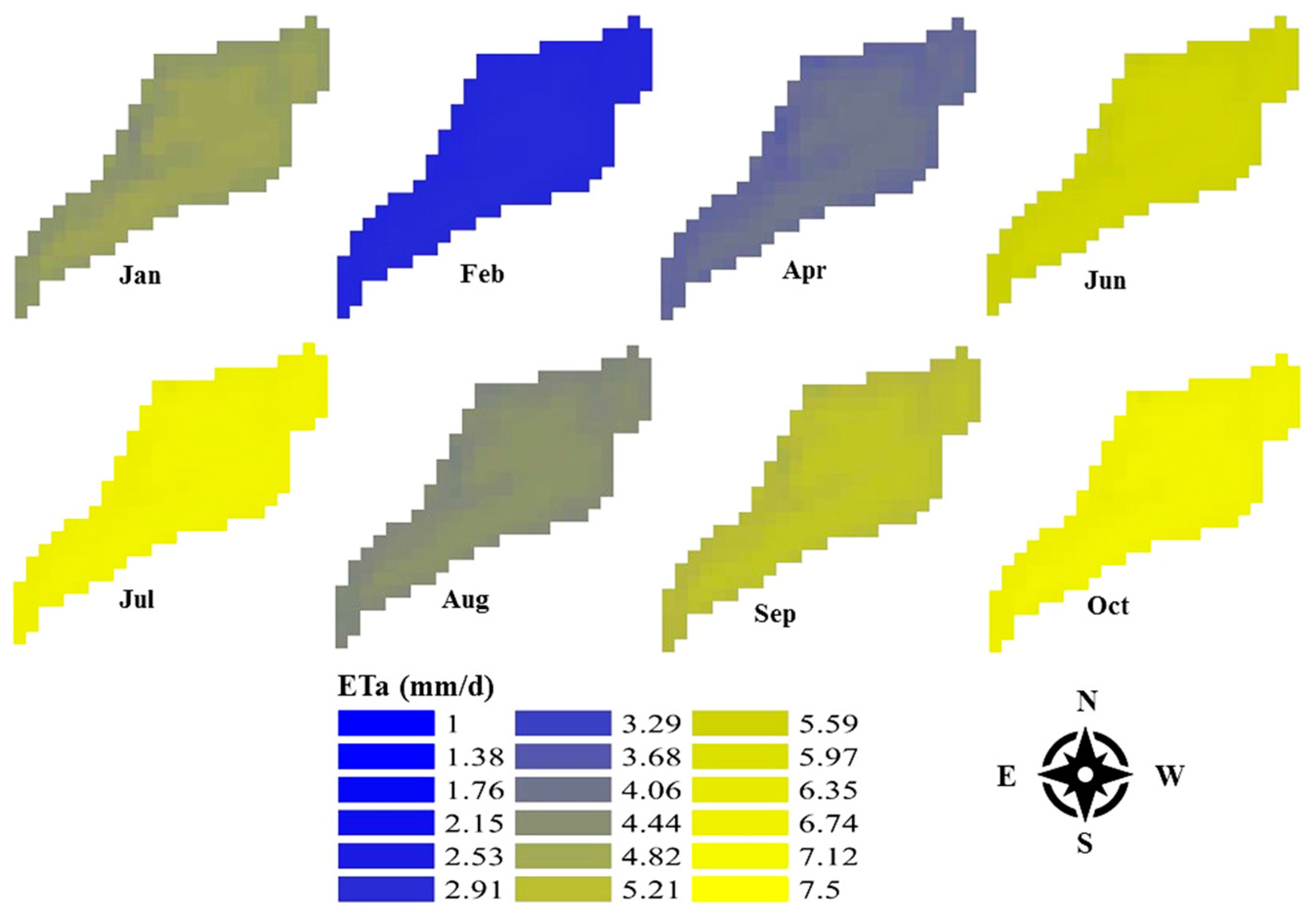
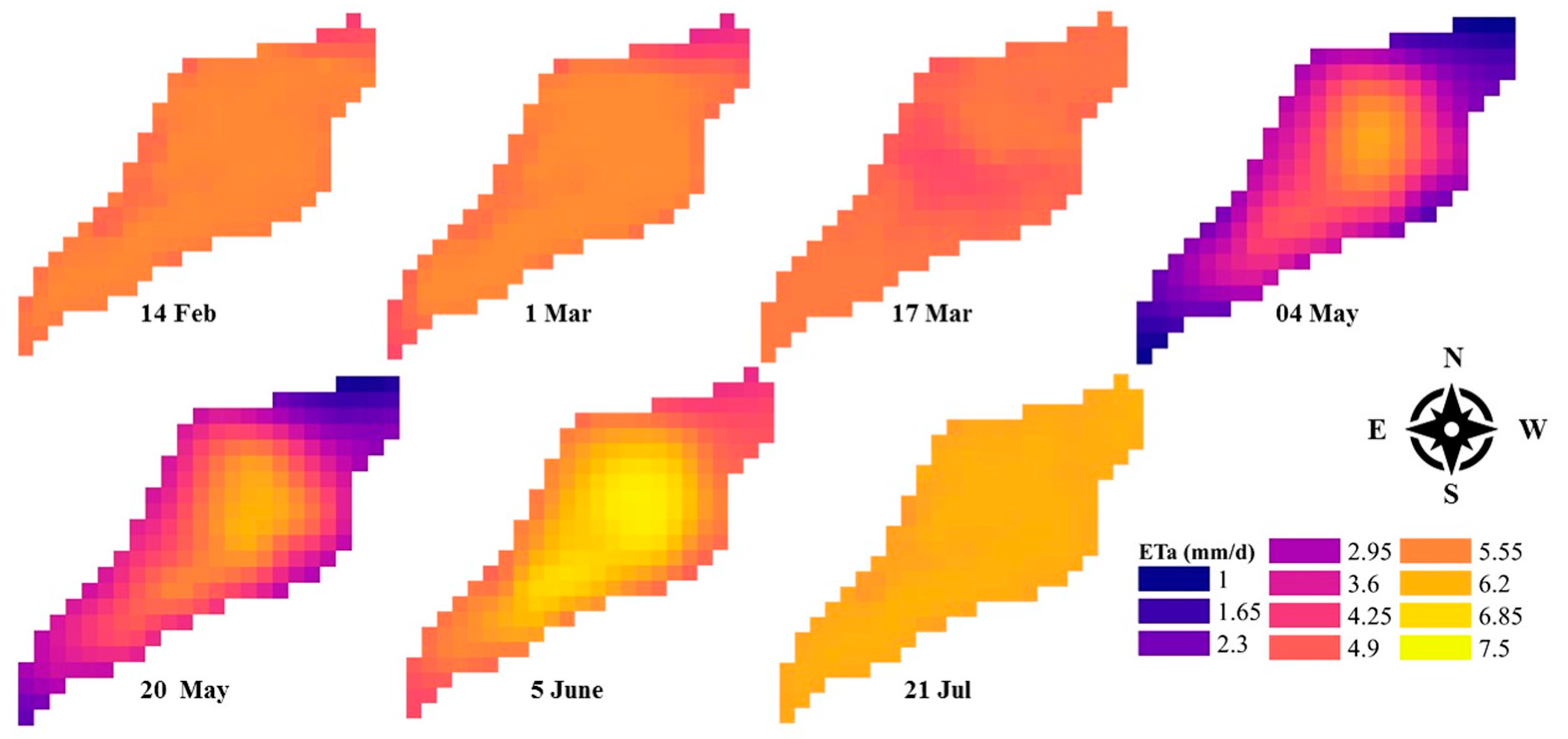
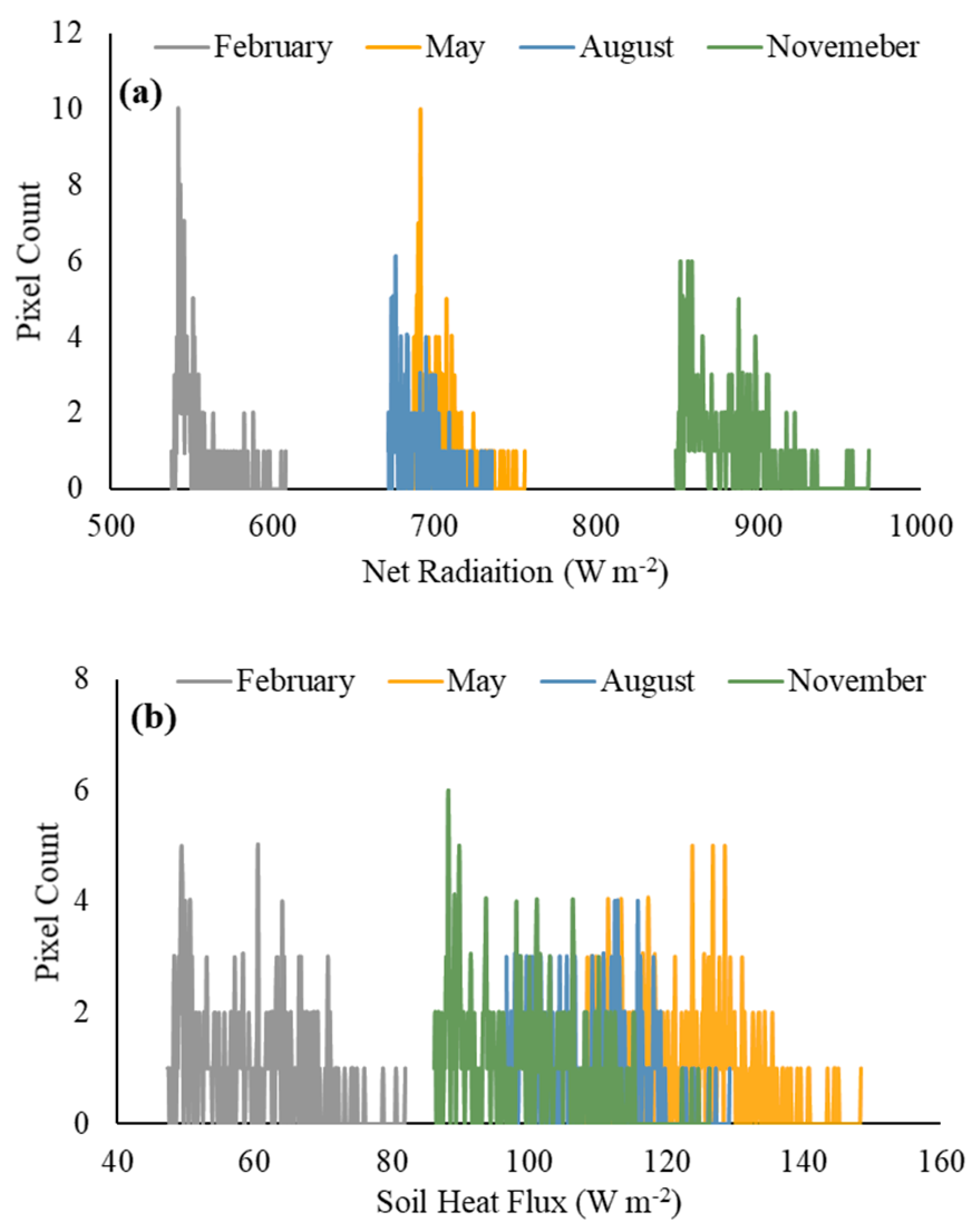

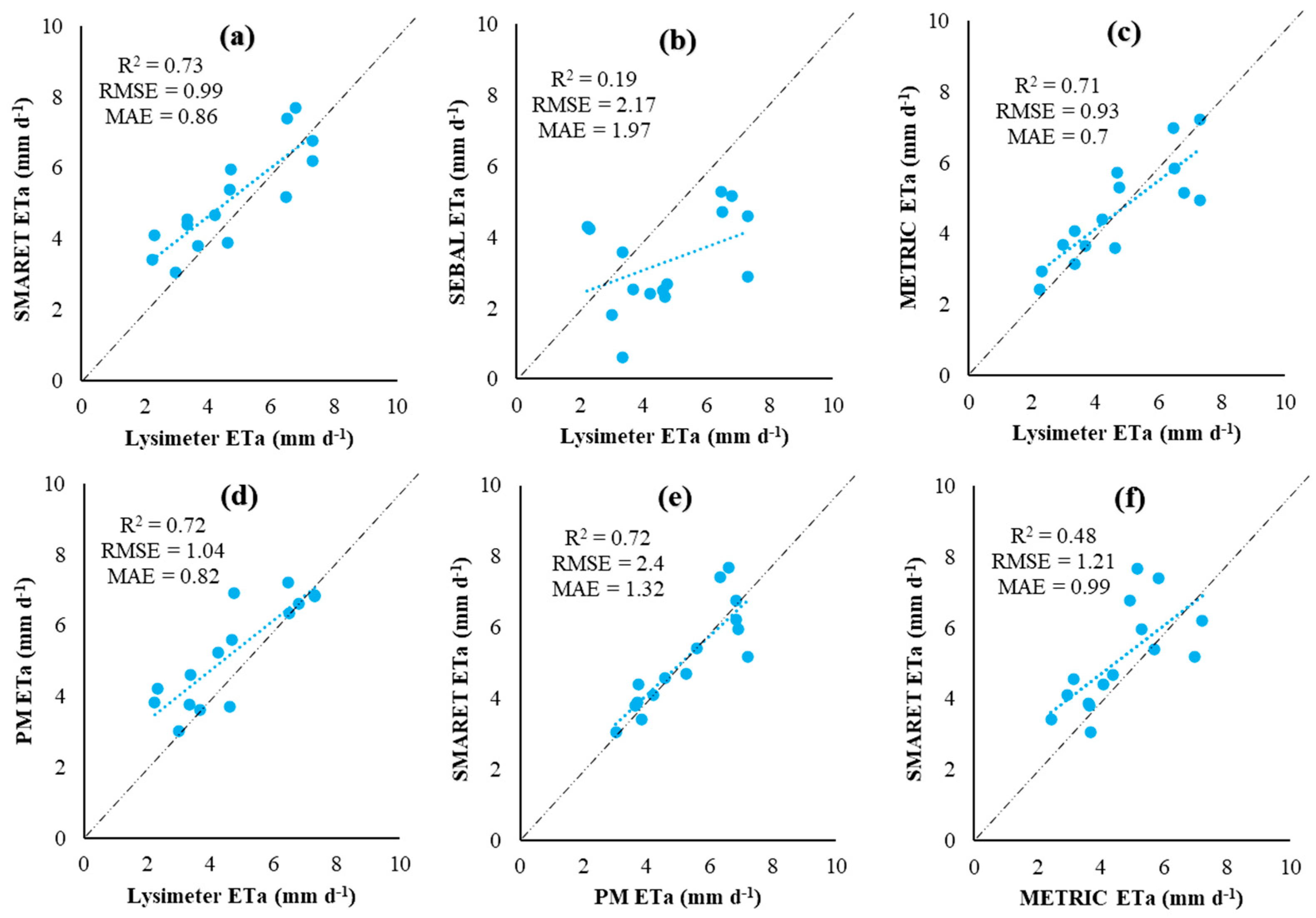
| Acquisition Time | 06:34:26.99 (GMT) | Temporal Resolution | 16-Days | ||
|---|---|---|---|---|---|
| No | Julian Day | Date | No | Julian Day | Date |
| 1 | 15 | 15 January 2015 | 14 | 61 | 1 March 2020 |
| 2 | 47 | 16 February 2015 | 15 | 93 | 2 April 2020 |
| 3 | 111 | 21 April 2015 | 16 | 109 | 18 April 2020 |
| 4 | 159 | 8 June 2015 | 17 | 125 | 4 May 2020 |
| 5 | 175 | 24 June 2015 | 18 | 157 | 5 June 2020 |
| 6 | 191 | 10 July 2015 | 19 | 173 | 21 June 2020 |
| 7 | 223 | 11 August 2015 | 20 | 189 | 7 July 2020 |
| 8 | 239 | 27 August 2015 | 21 | 237 | 24 August 2020 |
| 9 | 255 | 12 September 2015 | 22 | 253 | 9 September 2020 |
| 10 | 271 | 28 September 2015 | 23 | 269 | 25 September 2020 |
| 11 | 287 | 14 October 2020 | 24 | 285 | 11 October 2020 |
| 12 | 29 | 29 January 2020 | 25 | 317 | 12 November 2020 |
| 13 | 45 | 14 February 2020 | |||
| Annotation | Factor | Source | Units |
|---|---|---|---|
| A | Albedo | Multispectral imagery (Bands 2–7) | (-) |
| NDVI | Normalized difference vegetation indices | Multispectral imagery (Bands 3 and 4) | (-) |
| LST | Land surface temperature | Thermal imagery (band 10–11) | (°K) |
| Rn | Net radiation | Multispectral and thermal imagery (bands 2–7, 10, and 11) | (Wm−2) |
| G | Soil heat flux | Multispectral and thermal imagery (bands 2–7, 10, and 11) | (Wm−2) |
| H | Sensible heat flux | Multispectral and thermal imagery (bands 2–7, 10, and 11), in situ data | (Wm−2) |
| ρair | Air density | Scaler input | (Kg m−3) |
| Cp | Specific heat of air at constant pressure | Scaler input | (J kg−1 K−1) |
| Aerodynamic resistance to heat and air transport | Weather data | (s m−1) | |
| Surface roughness length | Height of canopy, NDVI | (m) | |
| U* | Friction velocity | Wind profile | (m s−1) |
| Zero-plane displacement | Mean height of the canopy | (m) | |
| Roughness length for Heat | Wind profile | (m) | |
| L | Monin–Obukhove length | Weather data imagery | (m) |
| Factor affecting atmospheric transmittance in air | Elevation of the study area | (m) |
| Month | dT = Tfh − Ta | dT = Tfh − Ts | dT = Ts − Ta |
|---|---|---|---|
| Jan | 5.76 | 2.7 | 3 |
| Feb | 7.74 | 6.8 | 0.9 |
| Apr | −0.42 | 5.1 | −5.5 |
| Jun | 2.67 | 9.9 | −7.2 |
| Jul | 1.48 | 7.4 | −5.9 |
| Aug | 3.11 | 5.4 | −5.4 |
| Sep | −7.72 | 6.3 | −6.3 |
| Oct | −0.81 | 2.8 | −2.8 |
| SD | 4.91 | 2.61 | 4.25 |
Publisher’s Note: MDPI stays neutral with regard to jurisdictional claims in published maps and institutional affiliations. |
© 2021 by the authors. Licensee MDPI, Basel, Switzerland. This article is an open access article distributed under the terms and conditions of the Creative Commons Attribution (CC BY) license (https://creativecommons.org/licenses/by/4.0/).
Share and Cite
Ali, A.; Al-Mulla, Y.A.; Charabi, Y.; Al-Rawas, G.; Al-Wardy, M. Satellite-Based Water and Energy Balance Model for the Arid Region to Determine Evapotranspiration: Development and Application. Sustainability 2021, 13, 13111. https://doi.org/10.3390/su132313111
Ali A, Al-Mulla YA, Charabi Y, Al-Rawas G, Al-Wardy M. Satellite-Based Water and Energy Balance Model for the Arid Region to Determine Evapotranspiration: Development and Application. Sustainability. 2021; 13(23):13111. https://doi.org/10.3390/su132313111
Chicago/Turabian StyleAli, Ahsan, Yaseen A. Al-Mulla, Yassine Charabi, Ghazi Al-Rawas, and Malik Al-Wardy. 2021. "Satellite-Based Water and Energy Balance Model for the Arid Region to Determine Evapotranspiration: Development and Application" Sustainability 13, no. 23: 13111. https://doi.org/10.3390/su132313111
APA StyleAli, A., Al-Mulla, Y. A., Charabi, Y., Al-Rawas, G., & Al-Wardy, M. (2021). Satellite-Based Water and Energy Balance Model for the Arid Region to Determine Evapotranspiration: Development and Application. Sustainability, 13(23), 13111. https://doi.org/10.3390/su132313111






